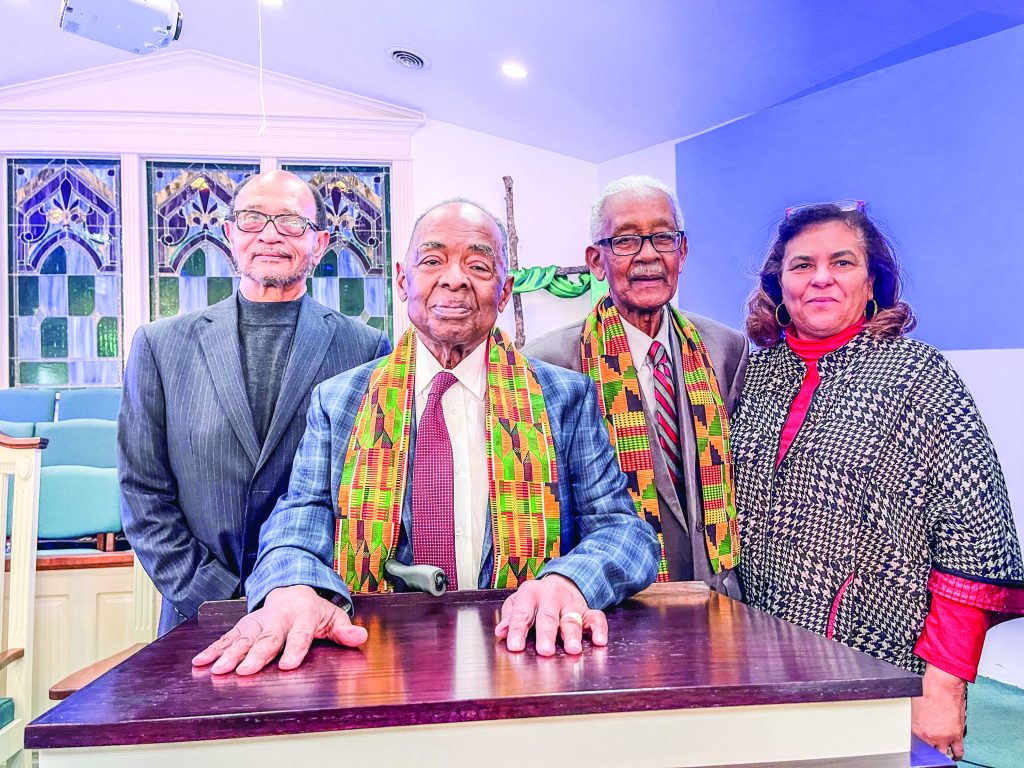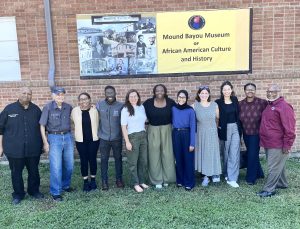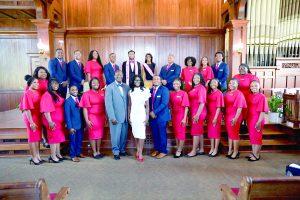Prepared remarks edited by Alice Thomas-Tisdale, JA Publisher Emerita
On Feb. 19, during his Black History Month address at Little Bethel AME Church in Terry, MS, Dr. Robert Smith thanked 92-year-old Mr. Morris Bozeman “who as a young Christian man taught me as a boy it was okay to be a Christian.” He also acknowledged that Mr. Bozeman was among those community leaders in Hinds County that helped his brother George become the first Black Supervisor from District 5 and George Thomas, the first Constable.
“Their work would be historic in that both Georges were elected in a majority white district. Later, George appointed Bennie Buckner as Constable. Their coattails paved the way for constables, judges, and other elected officials in a district that was majority white voting age.
“In contrast, District 2, which elected now Congressman Bennie Thompson as Supervisor, was thought to need 80% Black majority for him to be elected.”
Dr. Smith gave congregants a timeline documenting his illustrious life, filled to the brim with public service in the delivery of quality health care in underserved communities. He made mention of Eddie Lee and Eula Vee Polk’s family who provided the school bus that brought him to Little Bethel for Sunday school and church.
“This helped me develop leadership skills that have sustained me over the years,” Dr. Smith said. “I am thankful the Mack family, who I view as an extension of my own, was also a part of this church.
“My uncle Pozie Dixon served as a steward in those years. He could ride his horse sideways with his coat across his shoulders, and never had a wrinkle in his pants.
“I’m deeply happy that Papa Sutter Owens, a part of my blended family, was a founder of Little Bethel.”
Dr. Smith conveyed that the Owens family has served for five or six generations, producing local, state, and national leaders.
“Essentially, all of us were brought here as slaves landing in Jamestown in 1569. Many of our forebears died during the Middle Passage and were cast into the sea. Many of us were born and died in slavery without adequate medical care. Mississippi had the highest number of slaves, and we all may be related in some form or another, Blacks and whites,” stated Dr. Smith.
“Carter G. Woodson started Black History Week that has been extended to a month. How right he was that Black history is interwoven into American history, and the history of the world.
“Mississippi was unique as it had a system that held us back, then and now. From Reconstruction by lynch mobs, the KKK, constitutional changes that made us three-fourths a man, and most of all the health care system was virtually nonexistent. We had to depend on granny-trained midwives, witch and voodoo doctors, except in some special instances.”
According to Dr. Smith, prior to 1910, there were roughly 20 Black medical schools training Black physicians.
“In 1910, the Flexner Report closed predominantly Black medical schools.
“Thank God, two predominantly medical schools survived, Howard and Meharry. Howard trained me. The predominantly white medical schools at that point were training sometimes on average 15-25 Blacks yearly; some years, no Black students.”
Reverting back to his youth, Dr. Smith said, “I was born, as all of you know, here in Terry on Wynndale Road in a house that is 90 years old, or older. Segregation prevailed throughout Mississippi in the south. Our parents, Wilma Porter and Joe Smith, made a decision to take us out of a two room neighborhood school, along with the children of Pearl Summers and Walter Owens, to a four room schoolhouse now restored one block to the west of us. We must thank Ms. Robin Lathan for her restoration efforts in placing this former school on the historical registry.”
“The educational system of that day was an educational system that ill-prepared a man or woman to compete,” stated Dr. Smith. “It was educationally inferior and imposed a psychological inferiority on many of us that still persists today.
“There was no public high school in the county until 1949. Thankfully, the year I left grade school the county bought Utica Institute, a private high school founded by Mr. William Holtzclaw. This purchase, four years before the Brown vs Board of Education decision in 1954 was meant to say that educational opportunities in Hinds County were separate but equal. The city of Jackson had Lanier.
“I am blessed a group of students, including the late Robert Stevenson Jr., Odessa Jackson who lived with her sister, Emma Harvey, Ms. Marie Yates, living with her aunt, Mama Pearl Owens and I, would have the opportunity to stay at home and go to high school. We would walk to a central pickup point to catch a secondhand, unheated bus to ride 45 miles to where the Utica division of Hinds Community College is today.
“We left home in the dark and returned home in the dark routinely, and sometimes at night because the secondhand bus would break down. We repeated this walk, sometimes twice daily, if my dad wasn’t around to provide transportation home.”
Continuing, Dr. Smith admitted he was fortunate to have a village in Terry that included some of the aforementioned people along with Mr. William H. Garrett, who was Booker T. Washington trained and also helped train Mr. Harold McLain; both believed in academic excellence and discipline.
“I had my own parents in my life. Other men and women in my life included, Edward and Inez Owens; Charlie Horton, cattle salesmen; and my own brothers, John, Suter, Samuel, Joe Lee, and Wilard. They instilled in me the notion that I was a man who was not inferior and that I could do anything.”
Dr. Smith said he was fortunate to become familiar with Dr. Charles Drew because of a book given to him by his aunt and uncle called “Famous Black Americans.” “I found I had little talent and gave up piano and I first identified with Dean Dixon, a director of the New York philharmonic, and identified with Dr. Drew, a Black physician at Howard who did pioneering work in developing the process of transfusing blood plasma.
“I was also fortunate as a boy to become familiar with Dr. Khan, a Jewish physician at the VA who hunted birds on my dad’s property. My dad would send me into the woods with him. Dr. Khan would give me reading materials about health. At his retirement, he gave my dad his medical books I was able to read until after I started medical school.”
Dr. Smith went from the woods to being involved with 4H clubs and by the time he got to high school in 1949, he was winning top prizes for public speaking and livestock judging in New Farmers of America (NFA), now known as Future Farmers of America. “Winning took me to several county high schools in Mississippi, Alcorn College, and other HBCUs,” he said.
After garnering the status of a national officer in NFA, Dr. Smith spoke of spending summers in Washington, D.C. as a youth. “Historically, there were two distinct boards of education, one for the HBCUs in the 17 southern states and one for the white schools. We had to live at Howard University at Slowe Hall. As for public accommodations, Washington, D.C., was as segregated as Mississippi. Desegregation began in Washington during my medical school years.”
The year now was 1953. Dr. Smith started his college pursuit at Tougaloo. “I was fortunate,” he admits. “Out of a pre-health class of 25 talented students at Tougaloo, I was the only one to be accepted into medical school on the first pass. I have nightmares today about the tragedies many of my fellow students and friends endured because of racism. Many were more talented and gifted than I; their families suffered from shattered hopes and dreams of entering the health profession. Some never recovered.”
In 1957, Dr. Smith was accepted at both Howard and Meharry on the early decision plan. “A week or two later, I received acceptance from Howard. I knew Howard as I had lived there during the summer of my high school years from my participation in NFA. I don’t regret any of it. I was exposed to many nationally known figures such as Montague Cobb, Walter Lester Henry, Burt Synaphax, and many others. Chokwe Lumumba gave me an award back in the 1970s; Walter Henry’s brother, Imari Obadele, lived next door to me on Lewis St. I was at my home on Lewis St. during the 1971 shoot out and was one of the lead witnesses in federal court that led to their freedom.”
Dr. Smith trained at the City General Hospital doing pediatric rotations and at the VA hospital where he did his Medical rotations. At that time, there were no known Black physicians with full privileges at any major teaching hospital in the nation’s capital. However, there were attempts by Black physicians to integrate the American Medical Association (AMA).
Following medical school at Howard, Dr. Smith was accepted into the Cook County training program, the largest hospital in the country. “It is said, if you trained at Cook County and stayed there a few months, you would encounter most diseases in the world. That was so true. It even had an infectious disease hospital I rotated through when measles, mumps, whooping coughs, and TB and other infectious diseases were raging and incurable.
“There were many other hospitals in the complex. As one of two Black interns, I competed for one of the most sought after residencies,” he said, adding, “I was the second Black to receive a residency in OBGYN.”
During his stint in Chicago, Dr. Smith worked in healthcare during the day either at the University of Illinois or Cook County and at night as a steak broiler.
“I was shocked to find Chicago hospitals outside of the county as segregated as Mississippi hospitals. Only five Black doctors in Chicago had hospital privileges outside of the all Black hospital providence. I was fortunate to be a part of a group formed to end discrimination in Chicago hospitals.”
Dr. Smith was pulled from his residency at Cook County because of the Berlin Crisis. “As Mississippi was asked to supply 12 physicians, and again only because of racism, I could not accept my residency because they had the audacity to draft me to fulfill that quota.
“The Berlin Crisis went up and down. I was back home in Terry in limbo and could not go back to my training.”
The year now was 1962, and Dr. Smith was at home with nothing to do. He recalls Mississippi was going through its period of “interposition nullification” (against all change) with Ross Barnett the governor and other leaders. James Meredith was preparing to enter Ole Miss with an army battalion of over 30,000 troops, a few deaths, and several hundred injuries.
The Citizen Council was formed in 1955 in Greenwood, MS. The membership comprised local leaders such as doctors, lawyers, and store keepers who would pass the names of activists to the Sovereignty Commission. This was a state funded organization founded in 1957 that spied on whites and Blacks who were pro-integration. Similar to the KGB in Russia, they policed Blacks and whites. “They harassed all of us who were active, and ran many out of Mississippi. The assassins’ bullets killed Medgar Evers and so many others,” says Dr. Smith.
Still on leave from the draft, several things began happening simultaneously for Dr. Smith.
“Cecil Jaquith, the first known white hospital director to hire Black physicians, hired me to see Black patients in a segregated situation. At the same time, I was invited by the President of Tougaloo College, Dr. Daniel Bittell, to come to Tougaloo to provide health services during my off hours, and I reunited with Medgar Evers, attending mass meetings.”
Dr. Smith started volunteering his time to Tougaloo, providing health services. He also accepted a job at Mississippi State Hospital. Two weeks into his new routine, after leaving Tougaloo campus, Dr. Smith was forced out of his car by police, pushed into a patrol car, and taken to the Jackson city jail. “It was then that the importance of being home and my activist work was reinforced,” he said.
This would not be a singular encounter for Dr. Smith as he continued to participate in demonstrations against injustice, which included the AMA.
“I was living in my birth home in Terry, doing the usual as citizens do. I registered to vote in 1962 with resistance. Registering was still a hassle. The guy gave me the Constitution to interpret. In haste, and in anger, I pushed it off the ledge and told him, ‘I didn’t come here for harassment. I came to register.’ Despite this, I registered.”
There would be a hefty price to pay for Dr. Smith registering to vote. “I left my parents’ home due to personal harassment and finally the initials KKK being written on the Highway 55 bridge at Wynndale Road. I didn’t want my work to bleed into the peaceful life of my parents,” he said.
Housing was a problem in Jackson, but Dr. Smith found an old house on Lynch St. across the street from Jackson State College. “Imagine, a single man like me that provided a haven for activist students and faculty essentially on the campus where there was suppression at that time.
“Let me describe healthcare in the Jackson area at that time. My brother John suffered an injury to his legs and had been hospitalized in the Green Annex of Baptist Hospital. Out of fear for his health, my mother and his wife Rosie took him home.
“In 1959, I sat with my Uncle Joe Lee Hamilton in the basement of the old Baptist hospital.”
Separate waiting rooms were normal. Blacks were sometimes waiting in broom closets. Baptist Hospital had segregated privileges in Green Annex; St. Dominic and UMMC had no privileges at all for Black physicians.
“Physicians who had separate waiting rooms, in itself, denoted Blacks were second class. Few exceptions were found during that period. Dr. Mills and Richard Blount both opened integrated waiting rooms. Dr. Blount’s son, David Blount, would later become a state senator for this district.
“I recall another incident when my sister-in-law Virlee Bracey Smith had a car accident outside of the old Baptist emergency room. I was called and attempted to provide care. Thank goodness for Dr. Hudson’s intervention which prevented me from being arrested. He also correctly walked me and Dr. James Anderson through treating Dr. Martin Luther King Jr. through an illness we thought was appendicitis but turned out to be gastroenteritis.”
Dr. Smith vividly recalled the day his friend Medgar Evers was assassinated. “It was June 12, 1963. We were all devastated. Some of us had mourning gatherings, others participated in demonstration, including his funeral procession. We walked from the Masonic Temple to Collins Funeral Home on Farish Street. Initially, we were ordered not to cross Capitol Street. Fortunately, John Doer, an attorney from President Kennedy’s Administration, stepped out and led us across Capitol Street to Collins Funeral Home, preventing us from being slain in the streets of Jackson.”
Dr. Smith was among those who carried on the torch sparked by Medgar. “I wanted to do something more meaningful medically,” he said. “Two weeks later, the AMA, which is the gatekeeper of American medicine, was having its annual convention in Atlantic City. I later ended up working with Dr. Mike Hollman and Walter Lear to form The Medical Committee for Civil Rights to protest and picket the AMA.”
Dr. Smith stated, “Holman, Lear, and myself tried to present a petition to the AMA. We were thrown out of the house of delegates, and subsequently became the first physicians of record to picket the AMA because of its racist policies. We called attention, nationally and internationally, to racist healthcare in America. This was all over the major newspapers including the New York Times and television networks. Many carried it on the front page.
“As a Black physician from Mississippi, I represented everything that was wrong with American healthcare. I could not obtain hospital privileges and I could not belong to the local medical society.”
News reports gave Dr. Smith local and national attention he could not afford at that time. However, the day after he returned home, he was stopped by the Mississippi Highway Patrol, forced out of his car, taken to Dr. Jaquith’s office, and summarily fired.
He still refused to leave the state and instead opened an office at 1312 Lynch St. with Dr. John W. Davis, a local dentist. The Southern arm of the Medical Committee for Human Rights (MCHR) was formed and Dr. Smith became its Medical Director.
“Along with me, Drs. James Anderson, A.B. Britton, Jr., and Leslie Falk became the organizers. It was Dr. Falk, a Rhodes Scholar, who was sent by the New York office. He had led the fight to get Congress to pass legislation that compensated patients with Black lung disease.”
The following year is etched in American history. Mississippi became ground zero for the Civil Rights Movement. Bob Moses and others brought several thousand young students from major colleges and universities to participate in desegregation, open freedom schools, teach voter registration and education. This would later be the catalyst to form the Mississippi Freedom Democratic Party that ended up up seating the regular democrats that brought Fannie Lou Hamer and others to national and international fame.
The MCHR was very active during 1964, providing healthcare to visiting SNCC, NAACP, SCLC, CORE, and UL activists and at major marches in Mississippi and across the south, including the March Against Fear, the Selma March, and the Poor People’s Campaign.”
During that time, SCLC was headed by Dr. King, SNCC by Bob Moses and David Dennis, CORE by James Forman, and the Urban League by Whitney Young. “All of these men in my estimation were the best men that God created,” Dr. Smith believes.
“Thank God, Aaron Henry, president of NAACP, along with Medgar established civil rights sites in many parts of the state, and Aaron ended up being president of the Council of Federated Organizations (COFO), one of the few to have a direct line to the White House and other policy makers,” stated Dr. Smith.
During this period, the following were accomplished: The Civil Rights Act of 1964, The Voting Rights Act of 1965, The Fair Housing Act of 1966, and most important to Dr. Smith, President Johnson’s landmark health legislation starting with opening the Office of Economic Opportunity.
“Head Start and the Community Action Programs came in 1964 and in 1965 Community Health Centers were created. Medicare and Medicaid, enacted in 1965, were the cornerstones in bringing more healthcare to more Americans,” says Dr. Smith.
In 1966, regional medical programs and other programs brought advances in the care of Heart, Cancer, Stroke, Rehabilitation and later Renal Disease to local communities that persist today. Also set in place was Dr. Smith’s call for “a new institution.” It would be named Community Health Centers, now referred to as Federally Qualified Health Centers (FQHCs).
“Jack Geiger had seen a health center in South Africa. Over the next six months a group of us developed a proposal that ended up in Dr. Joe English’s office of the Office of Economic Opportunity (OEO). The proposal called for two centers, one in the north and one in the South. We would not mention Mound Bayou, Mississippi, because it would have been dead on arrival, but at the time we knew it would be Mound Bayou.”
Today, there 22 FQHCs in Mississippi and several thousands community health centers nationwide caring for 33 million Americans, 300,000 of them in Mississippi. There are several hundred Black providers working in health centers in Mississippi and more than 400 Black providers working in other venues throughout the state, including UMMC.
FQHCs have helped establish and support Black leaders such as Drs. James Anderson, Charles Humphrey, Harvey Sanders, Aaron Shirley, and current leaders including Drs. Smith, Helen Barnes, Jasmin Chapman, Robert Pugh, John Fairmon, and others.
Dr. Smith said, “President Obama took us further with health as a human right with the Affordable Care Act that some people use against us when they talk about Obama Care. Obama did not have the political muscle to go further as there are several thousand Americans who are still left uncovered. We are still struggling to get the Mississippi legislature to extend Medicaid which is a part of the Affordable Care Act.”
Dr. Smith was also instrumental in bringing Head Start to the state. He served as medical director for the now Friends of Children of Mississippi. He is also a charter member of the Community Action Program in Hinds County that funded Fannie Magee Jackson to bring Head Start to Terry.
“I was working with Archie Gray, who at that time was chief of Mississippi State Department of Health (MSDH) and chief of Medical License. I was trying to get his cooperation in examining stools of Head Start participants, and he said to me, ‘Boy, I will delicense you!’ I looked at him and grinned. I didn’t know what he could do other than put another barrier for me to climb over. I wasn’t doing anything that I knew was illegal, and it needed to be done.
“Through Friends of Children of Mississippi, we were able to provide Marian Wright Edelman horrible statistics about childhood malnutrition, anemia, intestinal parasites, vision, hearing, and other unmet issues of children that had never been seen by a physician. She was able to get Senator Bobby Kennedy to call a congressional hearing that brought about more funding for women and children.”
During this timeframe, medical schools were expanded from 93 to over 100. According to Dr. Smith, some states, instead of establishing a second medical school, increased its class size. UMMC went from a class size of 75 to 165. “The problem with UMMC is Black students remain underrepresented. We have not seen all the benefits of that money in Mississippi,” emphasized Dr. Smith.
A few years ago, Marian Wright Edelman invited Dr. Smith and Dr. Michelle Owens to retrace the Delta experience of more than 50 years ago. “There were periods in time that our efforts brought dignity, respect, and concern for the disadvantaged with the introduction of the social determinants of care to health care,” stated a proud Dr. Smith.
From its roots, Dr. Robert Smith is credited with being a part of Mississippi’s largest teaching and research institution, UMMC. He has worked with every vice chancellor starting with Marston, a fellow Rhodes Scholar of Dr. Falk who introduced them. The Department of Family Medicine has trained more family physicians, especially Black, than any other department at UMMC, many of whom have remained in Mississippi, but not enough, says Dr. Smith.
“During my tenure as Clinical Associate Professor, I became Co-Principal Investigator of Atherosclerosis in Communities (ARIC), a study that involved four other major universities throughout the USA with Mississippi, being the only Black cohort. This study is patterned after the Framingham study in Massachusetts that studied risk factors for hypertension, heart disease, and renal disease. This study at UMMC is now more than 30 plus years of age and gave rise to the Jackson Heart Study and the Mind Center at UMMC.
“Working with the late Vice Chancellor Norman Nelson and the late Vice Chancellor Wally Connerly, I was able to conduct a national search that brought Dr. Billy Ray Ballard to UMMC to serve as the first Black Vice Chancellor and Dr. Herman Taylor as the first Black Director of Jackson Heart Study.”
In Dr. Smith’s vast contributions to Black Resistance for social change, he sums it up this way: “I have worked all of my life to promote health as a human right.”






